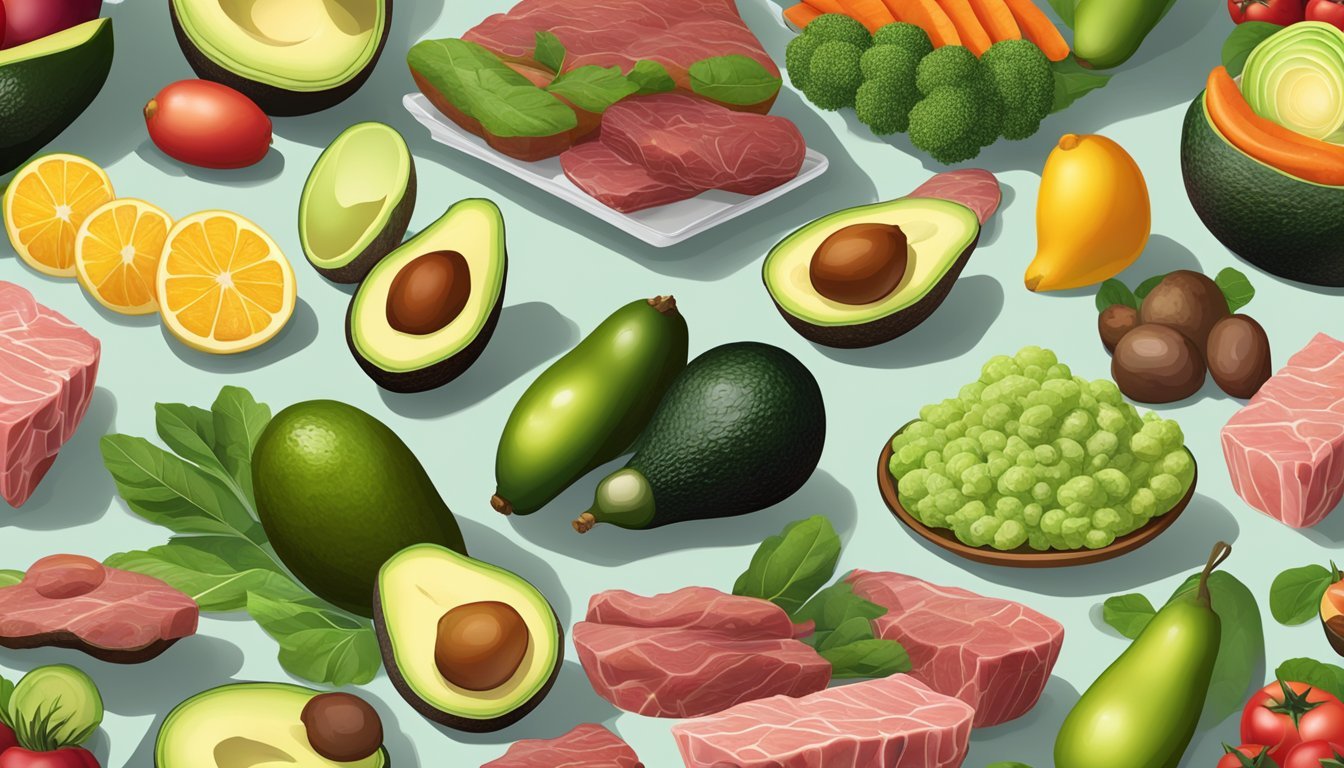Keto Diet: Eating at Buffets
Strategies for Low-Carb Success
Navigating the wide array of food options at buffets while adhering to a ketogenic diet can be a challenge. The ketogenic, or keto, diet emphasizes the importance of high-fat, moderate-protein, and very low-carbohydrate foods to induce a state of ketosis. This metabolic state shifts the body's energy reliance from carbohydrates to fats, potentially aiding in weight loss and improving overall energy levels. When approaching a buffet, individuals on a keto diet must select nutrient-dense, low-carb options to maintain their dietary regimen.
Buffet dining on the keto diet requires a strategic approach to food choices. Healthy fats such as those from avocado, olive oil, and certain nuts and seeds are integral to the keto diet and can often be found in buffet settings. Protein sources like meat, fish, and eggs are also keto-friendly and commonly available at buffets. However, the challenge lies in avoiding high-carb foods that are prevalent at such establishments, namely breads, pastas, and sugary desserts. Instead, keto dieters should focus on vegetables, especially leafy greens and non-starchy varieties, which provide essential nutrients without excessive carbohydrates.
It's essential for those on a ketogenic diet to plan ahead before attending a buffet to ensure a variety of suitable options are available. Knowledge of keto-friendly foods enables the diner to make informed choices and create a satisfying meal. By concentrating on whole, unprocessed foods and steering clear of items with hidden sugars or starches, individuals can enjoy buffets while continuing to adhere to the principles of their keto lifestyle.
Understanding Keto Diet Fundamentals
When embarking on a ketogenic diet, key considerations include understanding what ketosis entails, the pivotal role of carbohydrates, and the benefits of a high-fat nutritional regimen.
What Is Keto?
The ketogenic, or 'keto', diet is a nutritional approach focused on consuming high-fat, moderate protein, and very low carbohydrate foods. Its goal is to shift the body's primary energy source from carbohydrates to fats. This transition pushes the body into a metabolic state termed ketosis, where it efficiently burns fats for energy.
The Role of Carbohydrates
Carbohydrates typically serve as the body's primary energy source. In a keto diet, their intake is severely restricted to around 20-50 grams per day, aiming to eliminate the body's reliance on glucose. It's essential to discern between total carbs and net carbs — the latter being total carbs minus fiber content, which has a minimal impact on ketosis.
Benefits of a High-Fat Diet
A diet rich in healthy fats is central to keto. These fats help to satisfy hunger, supply steady energy, and can lead to improved levels of high-density lipoprotein (HDL), often dubbed 'good' cholesterol. By consuming fats as the main source of calories, one may experience weight loss, improved insulin sensitivity, and other potential health benefits without the sensation of constant hunger.
Navigating Buffets on a Keto Diet
When at a buffet, a person following a ketogenic diet must carefully choose low-carb vegetables, high-quality proteins, and be vigilant to avoid hidden sugars and starches that can disrupt ketosis.
Choosing Low-Carb Vegetables
Individuals should prioritize leafy greens and non-starchy vegetables. Options such as spinach, broccoli (how long does broccoli last?), and cauliflower are packed with nutrients while being low in carbs. Avoid vegetables with sweeter tastes or heavier textures, which are usually higher in carbohydrates.
Eat: Spinach, kale, zucchini, mushrooms
Avoid: Corn, carrots, peas, potatoes
Selecting High-Quality Proteins
Buffets provide a variety of protein options. Seek out lean meats, such as grilled chicken or fish, which should be staples for maintaining muscle mass and satiety. They can also opt for eggs, bacon, and cheese for added fat and protein. Remember to check if meats are breaded or marinated in sugary sauces, which are not suitable for a ketogenic diet.
Recommended Proteins: Chicken, fish, eggs, bacon, cheese
Caution: Watch out for added sugars in sauces and dressings
Identifying Hidden Sugars and Starches
Sauces and dressings at buffets are often where sugars and starches hide. Patrons should either opt for clear dressings or simply use olive oil and vinegar. Avoid foods that are likely to contain hidden carbs like rice and breaded items. One should also steer clear of fruits with high sugar content.
Foods to Approach with Caution: Sauces, dressings, rice, bread
Preferable Choices: Olive oil, vinegar, meats without sauces
Meal Composition and Portion Sizes
When navigating buffets on a ketogenic diet, understanding macronutrients, managing portion sizes, and choosing the right fats can make or break the dietary success.
Understanding Macronutrients
Macronutrients are the cornerstones of the ketogenic diet, with primary focus on fats, moderate emphasis on protein, and strict limitation on carbohydrates to maintain ketosis. At a buffet, individuals should select foods with high fat and moderate protein content while minimizing carb intake. Recognizing sources of lean and fatty proteins, as well as differentiating between simple and complex carbohydrates, is crucial.
Proteins: Opt for fatty cuts of meat like ribeye steak (What wine goes well with ribeye steak?) or salmon.
Carbohydrates: Look for non-starchy vegetables like spinach or broccoli.
Fats: Choose foods rich in healthy fats such as olives or cheeses.
Calculating Net Carbs and Portion Control
Calculating net carbs (total carbs minus fiber and sugar alcohols) helps maintain ketosis and manage portion sizes effectively. Being on a keto diet doesn't mean eating unlimited quantities; calories still matter for overall health and weight maintenance.
Net Carbs Calculation Example:
1 avocado = Total Carbs: 17g - Fiber: 13g = Net Carbs: 4g
Keep your daily net carb intake between 20-50g and adjust portions accordingly.
Incorporating Healthy Fats and Oils
Healthy fats and oils are pivotal for satiety and energy. Include a variety of fats from different sources to ensure a well-rounded diet.
Sources of Healthy Fats:
Olive oil: Drizzle over salads.
Butter: Add a pat to cooked vegetables (how long do cooked vegetables last?).
Heavy cream: Use sparingly in coffee or tea.
Avocado: Full of monounsaturated fats, perfect for any meal.
Nuts and Seeds: A handful can serve as a nutritious snack or garnish.
Choosing the right portion sizes of these will ensure you stay within your macros while enjoying diverse tastes and textures without overconsumption.
Specific Dietary Considerations
When adopting a keto diet, individuals must tailor their buffet choices to support their unique health objectives, such as weight loss, diabetes management, or maintaining vegetarian keto principles. Each category presents distinct considerations for optimal dietary planning.
Keto for Weight Loss
For those focusing on weight loss, the ketogenic diet aims to enter a metabolic state called ketosis, where the body burns fat for fuel instead of carbohydrates. At a buffet, individuals should prioritize high-fat and protein-rich foods while avoiding carb-heavy items. Options such as:
Boiled eggs
Grilled meats
Leafy greens
are excellent for staying within keto macronutrient ratios, thereby supporting weight loss efforts.
Keto for Diabetes Management
Individuals managing type 2 diabetes can benefit from the keto diet as it can help regulate blood sugar levels and reduce insulin levels. At a buffet, they should select foods that have minimal impact on blood sugar. They should opt for:
Non-starchy vegetables
Protein sources like chicken or fish, ensuring they are not breaded
Monitoring portion sizes and avoiding sugary sauces and dressings is also crucial to maintain a low-carb intake.
Vegetarian Keto Options
Vegetarians on the keto diet can find buffets challenging, yet they can make smart choices by including:
Nuts and seeds: Serve as great sources of fat and protein
Tofu: A versatile protein which can be added to salads or vegetable dishes
These options allow vegetarian keto dieters to enjoy a variety without straying from their dietary restrictions. It's important to check that vegetable dishes aren't prepared with high-carb ingredients like potatoes or sweetened sauces.
Avoiding Common Mistakes
When adopting a keto diet and navigating the buffet setting, diners must pay close attention to specific dietary details to maintain their regimen. Recognizing these nuances allows for a more successful and health-conscious experience.
Reading Labels Carefully
At buffets, not all food items come with labels, but when they do, reading them is critical. Nutritional labels provide essential information about carb counts, saturated fat, calories, and sugar content. Individuals should look for hidden carbs and sugars that could disrupt ketosis and contribute to developing conditions like heart disease or high blood pressure.
Managing Hunger and Cravings
Buffets can challenge one's resolve due to the vast array of options. To manage hunger and cravings, they should start with protein-rich foods to promote satiety. It's advisable to eat slowly and drink plenty of water to reduce the likelihood of overeating, which can lead to excessive consumption of calories and carbs.
Resisting Temptation at the Buffet
The key to resisting temptation is to have a plan before approaching the buffet. Individuals should stick to the outer edges of the buffet where healthier options like salads, vegetables, and grilled proteins are often located, as these items generally contain lower carbs and sugars. Avoiding processed and fried foods (What wine goes well with fried foods?) reduces the risk of consuming hidden carbs and unhealthy fats. Those who are on medication for conditions like diabetes or high blood pressure should remain particularly vigilant, as dietary missteps can necessitate adjustments to their treatment.
Keto-Friendly Buffet Strategies
When approaching a buffet while adhering to a ketogenic diet, individuals should focus on identifying low-carb options, opting for creative alternatives, and selecting proper beverages for hydration.
Finding Keto-Friendly Options
One should begin by scanning the buffet for high-protein offerings such as grilled chicken or fish—these are usually low in carbohydrates and align well with keto principles. Vegetables, especially leafy greens, can serve as a foundation for meals; they are a source of essential nutrients without significantly adding to the carb count. For added fats and proteins, one might include options like boiled eggs, nuts, and cheese.
Proteins: Grilled chicken, fish, turkey
Vegetables: Leafy greens (spinach, kale), broccoli, cauliflower
Healthy Fats: Nuts, cheese, avocados
Creative Low-Carb Alternatives
Buffets often provide a variety of choices that can be cleverly assembled to comply with a ketogenic diet. One could construct lettuce wraps using cold cuts and fresh vegetables or craft a personalized salad with an abundance of high-fat foods—such as cheese and olives—and low-carb vegetables. For those craving a crunch, seed crackers can be paired with a variety of dips.
Lettuce Wraps: Cold cuts, cheese, avocado
Salads: Customize with high-fat toppings (cheese, hard-boiled eggs)
Dips: Full-fat dressings, guacamole
Hydration and Keto Beverages
Maintaining hydration is key, and one should be mindful to choose drinks that align with keto goals. Water is the quintessential choice, but for those looking for variety, flavored water—unsweetened or sweetened with keto-approved sweeteners—may also be enjoyed. These beverages aid in managing water weight and hydrate without increasing body fat.
Beverages: Water, unsweetened flavored water, coffee, tea
Avoid: Sugary drinks, fruit juices, soda
By employing these strategies, diners can navigate a buffet with confidence, ensuring that their choices support their ketogenic lifestyle.
Keto Diet and General Health
The ketogenic diet, when followed consistently, may impact various aspects of health, including cardiovascular health markers and metabolic functions. The diet's low-carbohydrate, high-fat approach has been scrutinized for benefits beyond weight loss.
Effects on Blood Pressure and Cholesterol
Adhering to a ketogenic diet may lead to changes in blood pressure and cholesterol levels. Studies suggest that the diet can reduce high blood pressure, an essential factor for cardiovascular health. The impact on cholesterol is more complex, as it often increases levels of HDL (high-density lipoprotein), considered to be 'good' cholesterol, which may protect against heart disease. Additionally, it may lead to lower levels of LDL (low-density lipoprotein) particle concentration, another positive change in reducing cardiovascular risk factors.
Keto Diet in Disease Prevention
In the context of disease prevention, the ketogenic diet has been specifically noted for its utility in managing epilepsy. The diet can reduce the frequency and severity of seizures in many individuals with epilepsy. Moreover, emerging research indicates that the diet may be beneficial in preventing the progression of type 2 diabetes, as evidenced by improvements in glycemic control and A1C levels. There is also interest in the diet's potential in preventing the onset of obesity and related metabolic disorders.
Keto and Longevity
While research is ongoing, there is speculation regarding the ketogenic diet's effect on longevity. Some studies suggest that the metabolic state of ketosis might offer longevity benefits by reducing inflammation and improving mitochondrial function. However, data is still inconclusive, and more research is necessary to determine the long-term impact of a ketogenic diet on lifespan. Maintaining consistent eating habits with a focus on nutrient density is key to optimizing the potential health benefits of this diet.
Conclusion
When dining at a buffet while following a keto diet, individuals can still enjoy a range of healthy foods that align with their nutritional goals. Salads serve as a substantial foundation for a keto-friendly meal, with additions like olives, nuts, and cheese contributing to both taste and satiety.
Attendees should focus on:
Meats: Opt for fatty cuts that are grilled or roasted.
Greens: Leafy vegetables are low in carbs and high in fiber.
Fats: Drizzle olive oil or full-fat dressings for added flavor and keto compliance.
Protein: Lean toward foods like hard-boiled eggs and seafood for protein sources.
Studies indicate that the keto diet can be effective for short-term weight loss. While the first days of dietary adjustment may introduce side effects, the overall nutritional approach rewards adherents with energy and reduced cravings.
Key Considerations:
Avoid breaded or sugar-laden options that disrupt ketosis.
Utilize high-fat, low-carb toppings to enhance salads.
Stay aware of hidden carbs in sauces and dressings.
Individuals should consult with a nutritionist to ensure that their selections at a buffet provide the necessary macronutrients to sustain a balanced ketogenic lifestyle. With careful choices, one can enjoy a buffet setting without compromising their dietary commitments.






